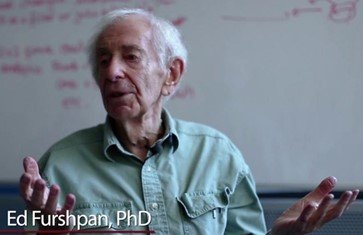Edwin J. Furshpan ’50

Edwin Furshpan began his career in neurobiology at a time when two principles of synaptic transmission had finally been firmly established: first, that signaling in the nervous system is unidirectional and occurs through chemical transmission; and second, that each neuron secretes only a single neurotransmitter. Through a series of influential experiments over the course of his career, many with David Potter, Furshpan extended our understanding beyond these precepts to reveal a richer world of possibility for synaptic mechanisms and for neuronal identities. His scientific papers were invariably original, addressed to important questions, and notable for their rigor and technical innovation. In addition to his scientific contributions, Furshpan, along with his colleagues, David Potter and Edward Kravitz, were influential in developing new ways of teaching neurobiology and, particularly, in working to extend access of underserved student populations to medical science and to neurobiology.
Education and Post-doctoral Training
Furshpan’s fascination with scientific research began with a project on the movement of insect wings during flight when he was an undergraduate. Working with Edward Boettinger at the University of Connecticut (Storrs) and at Woods Hole, he invented a method of recording based on electrostatic charge that allowed the study of very fast insect wing movements which were not previously observable. Furshpan pursued his Ph.D., studying muscle stretch receptors in crayfish with Cornelius Wiersma at the California Institute of Technology.
For his post-doctoral training, Furshpan spent several remarkably productive years in the laboratory of Bernard Katz in the Department of Biophysics, University College London. His first study followed the observation by Fatt and Katz (J Physiol 117:109-128, 1952) of spontaneous presynaptic release of acetylcholine at the frog neuromuscular junction as revealed by miniature end plate potentials of uniform size. They found that the frequency of the spontaneous potentials was affected by small changes in the osmolarity of the bathing solution. Furshpan extended this work by showing that the time course of the effect depended on the membrane permeability of the solute. Thus, membrane impermeant solutes such as NaCl or sucrose gave profound, and long-lasting changes, while permeable solutes such as ethanol and sucrose yielded only small and transient changes in spontaneous neurotransmitter release.